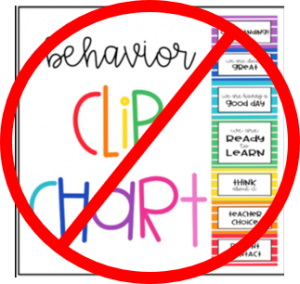The indirect and direct strategies introduced are all consequences. That is, using the A-B-C model, they are the “C”. The consequence is simply what happens after a behavior error occurs. The goal of using these strategies is to decrease future occurrences of the behavior error(s). Although in technical behavioral terms they are called “punishment,” these corrective consequences are not designed to be punitive, but instead to be instructional – to support the student to perform the expected behavior. In the previous activity, you may have found yourself seeking additional consequences for some of the example behaviors.
Teachers use corrective consequences frequently in response to behavior errors (e.g., loss of an activity, making up missed work, returning to desks and lining up again, etc.), particularly when behavior errors are repetitive or not responding to teaching strategies alone. In this section we will explore how to select and strategically use additional corrective consequences.
 CORRECTIVE CONSEQUENCES ARE NOT PUNITIVE. Corrective consequences paired with teaching of the expected behavior can increase the likelihood of behavior change. Effective consequences result in greater learning and often involve learning tasks or opportunities directly related to the behavior error. In fact, they are similar to instruction we might use when students are making academic errors. When students make errors in content are work, we might provide a brief correction, do some re-teaching, find additional practice opportunities to help them master the content, and provide positive feedback when they start getting it right.
CORRECTIVE CONSEQUENCES ARE NOT PUNITIVE. Corrective consequences paired with teaching of the expected behavior can increase the likelihood of behavior change. Effective consequences result in greater learning and often involve learning tasks or opportunities directly related to the behavior error. In fact, they are similar to instruction we might use when students are making academic errors. When students make errors in content are work, we might provide a brief correction, do some re-teaching, find additional practice opportunities to help them master the content, and provide positive feedback when they start getting it right.
Using the indirect and direct strategies, along with opportunities to role-play or practice the expected behavior, and a logical related additional consequence demonstrate the same instructional approach to behavior we would take with academic errors. Effective consequences maintain student dignity and invite the student to take responsibility for his/her behavior and be a part of the solution. Even though consequences for behavior errors are intended to be educational, they are also mildly aversive. That is, they require effort and should leave little incentive to repeat the error.
CONSISTENCY, NOT SEVERITY, IS IMPORTANT. It is not the severity of the consequence that promotes behavior change, but the certainty that something will be done. This is a common misunderstanding as we often look for a bigger consequence – the one that will stop the behavior. Yet, increasingly harsh consequences can actually lead to further behavior errors. An overemphasis on punishment focuses the attention of the student on the looming consequence and limits their consideration of the effect their behavior has on others or themselves (Alberto & Troutman, 2012). It is a common misconception that severe consequences (like suspension) will deter students from engaging in the behavior in the future. In fact, the best predictor of future suspension is a previous suspension. We don’t need a bigger stick; we need a consistent response – a guarantee that behavior errors will be addressed. When students who tease or call names see that the teacher consistently responds with a strategy and a consequence, every single time, they will be more likely to use the expected behavior.
CORRECTIVE CONSEQUENCES SHOULD BE SELECTED INDIVIDUALLY. Consequences are best when they are selected to fit the individual, the specific behavior, and setting. For a middle school student who made unkind remarks to a substitute, having a conference with the student to discuss the impact of the remarks, and having the student come to the classroom during a break or free period for some role-playing of respectful interactions in different situations could be very effective. For the student having difficulty getting along at recess with a peer, planning an activity that they can successfully do together might be effective. In both of these examples the standard of respect is being consistently upheld, but the consequences are personalized.
 Adults get caught up in the idea that different consequences for individuals is not fair. Fairness and consistency are achieved through clear expectations and standards that are upheld for all. Consequences in upholding those standards may be different as appropriate for the student. Fairness doesn’t mean that everyone gets the same thing. Fairness means that everyone gets what they need in order to be successful and meet the standard.
Adults get caught up in the idea that different consequences for individuals is not fair. Fairness and consistency are achieved through clear expectations and standards that are upheld for all. Consequences in upholding those standards may be different as appropriate for the student. Fairness doesn’t mean that everyone gets the same thing. Fairness means that everyone gets what they need in order to be successful and meet the standard.
 RESPONSE COST SYSTEMS CAN PROMOTE CHRONIC BEHAVIOR ERRORS. “Response cost is when points, tokens, privileges, or other reinforcers already given to a student are removed contingent on instances of a specific behavior or behaviors” (Storey & Post, 2012, p. 92). Some common examples include clip charts, red, yellow, green cards, taking away points already earned, taking away tickets, or taking away earned free time. These practices are best avoided for students of all ages.
RESPONSE COST SYSTEMS CAN PROMOTE CHRONIC BEHAVIOR ERRORS. “Response cost is when points, tokens, privileges, or other reinforcers already given to a student are removed contingent on instances of a specific behavior or behaviors” (Storey & Post, 2012, p. 92). Some common examples include clip charts, red, yellow, green cards, taking away points already earned, taking away tickets, or taking away earned free time. These practices are best avoided for students of all ages.
Response cost alone can be discouraging to students. Students who struggle with social behavioral issues may perceive they can’t meet the goals or expectations and therefore give up. Response cost may actually increase the likelihood of inappropriate behavior rather than reduce it.
Access a presentation about alternatives to the clip chart here: Moving Past the Clip Chart
OTHER CONSIDERATIONS. The following lists provide some common consequences reflecting logical, setting-specific responses to social/behavioral errors. The goal is to use consequences as needed to help students correct behavior errors. Be sure to pair any additional consequence with teaching and within an environment of a 4:1 ratio of specific positive feedback to corrective feedback.
- Planning or problem solving
- Extra practice or role-play of social/behavioral skill
- Make up missed work
- Alteration of activity
- Temporary removal from activity
- Note sent home
- Make amends to others
- Phone call to parents
- Loss of privilege
- Restitution
- Referral to counseling or behavior groups
- Parent conference
- Office referral
Consequences in Context
|
How to Transition |
Corrective Consequences |
|---|---|
|
During Science Lab
|
Procedures for Lab |
Corrective Consequences |
|---|---|
|
|
Activity
Select one of your classroom procedures. Brainstorm a list of possible corrective consequences in response to a behavior error. Be specific and list as many as possible.
Are the consequences instructional and logical? That is, do they help the student to learn, do, or practice the desired behavior?
When your list is complete order them by increasing intrusiveness.




